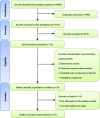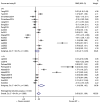The effects of manual therapy in pain and safety of patients with knee osteoarthritis: a systematic review and meta-analysis
- PMID: 38504373
- PMCID: PMC10949788
- DOI: 10.1186/s13643-024-02467-7
The effects of manual therapy in pain and safety of patients with knee osteoarthritis: a systematic review and meta-analysis
Abstract
Background: Manual therapy (MT) is frequently used in combination with management of osteoarthritis of the knee, but there is no consensus on the exact efficacy of this treatment strategy. The purpose of this systematic review and meta-analysis was to evaluate the pain relief and safety of MT for treatment of knee osteoarthritis (KOA).
Methods: Randomized controlled trials evaluating MT in patients with KOA in major English and Chinese journals were searched in the following databases: Wanfang, China Science and Technology Journal Database (VIP database), China National Knowledge Infrastructure (CNKI), PubMed, Embase, Web of Science, and the Cochrane Library databases through June 2023. The methodological quality and quality of evidence of the included studies were assessed using Cochrane's risk-of-bias 2 (ROB 2) tool and the Grading of Recommendations Assessment, Development, and Evaluation (GRADE) tool. Data analysis was performed using Stata version 15.0 software. After use of Galbraith plots to exclude studies that could lead to heterogeneity, random effects models were used to analyze the remaining data and test the consistency of the findings. We used meta-regression to assess the effect of treatment period, patient age, and sex ratio on outcomes. Funnel plots and Egger's test were used to evaluate publication bias. Sensitivity analyses were used to determine the reliability of the results.
Results: A total of 25 studies, with 2376 participants, were included in this review. The overall methodological quality of the included studies was limited. Our findings suggest that MT has a positive impact on pain relief outcomes in KOA patients. The meta-analysis showed that MT was superior to usual care (SMD = 2.04, 95% CI 0.94, 3.14, I 2 = 96.3%; low evidence quality) and exercise (SMD = 1.56, 95% CI 0.41, 2.71, I 2 = 96.3%; low evidence quality) for reducing pain. In terms of improvement in visual analogue scale (VAS) scores, MT treatment beyond 4 weeks (SMD = 1.56, 95% CI 0.41, 2.71, I 2 = 96.3%) may be superior to treatments less than or equal to 4 weeks (SMD = 1.24, 95% CI 0.56, 1.95, I 2 = 94.7%). No serious adverse events associated with MT were reported.
Conclusions: MT may be effective at reducing pain in patients with KOA and may be more effective after a 4-week treatment period. Compared with usual care and exercise therapy, MT may be superior at reducing KOA pain in the short term (9 weeks), but its long-term efficacy requires careful consideration of evidence-based outcomes. MT appears to be safe for KOA patients, though clinicians should inform patients of the potential risk of MT-related adverse events.
Keywords: Knee osteoarthritis; Manual therapy; Meta-analysis; Pain; Safety.
© 2024. The Author(s).
Conflict of interest statement
The authors declare that they have no competing interests.
Figures








References
-
- Hunter DJ, Bierma-Zeinstra S. Osteoarthritis Lancet. 2019;393:1745–1759. - PubMed
-
- Wojcieszek A, Kurowska A, Majda A, Liszka H, Gądek A. The impact of chronic pain, stiffness and difficulties in performing daily activities on the quality of life of older patients with knee osteoarthritis. Int J Environ Res Public Health. 2022;19:16815. doi: 10.3390/ijerph192416815. - DOI - PMC - PubMed
Publication types
MeSH terms
Grants and funding
- 81973973/The National Natural Science Foundation of China
- SHDC2020CR4055/Clinical Research Plan of SHDC
- ZYYCXTD-C-202008/Support Program for Chinese Medicine Innovation Teams and Talents of the State Administration of Traditional Chinese Medicine
- SHDC2022CRW010/Construction of research-oriented wards of SHDC
- SHDC2022CRT018/Three-year action plan to promote clinical skills and innovation capabilities of SHDC
LinkOut - more resources
Full Text Sources
Medical

